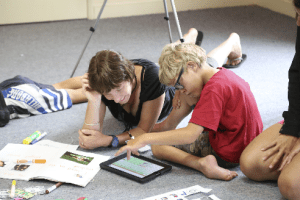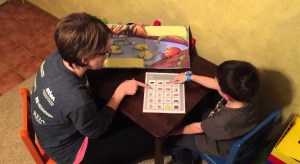Tip of the Month April 2015 – Modelling
Tip of the Month April 2015
Modelling
By Fern Jones (SLT)

Language learning is a fun and exciting time. Parents will often share stories of interesting things their child has said or phrases that have been picked up from ‘mum and dad’ talk. We all learn language through exposure to it via relationships we make with our primary care givers. Without these relationships and the role the caregiver(s) take in shaping the language of the child, language would be very difficult to learn or acquire. We are reliant on the relationships with those around us to label and teach us things about our native language. This is no different for users of AAC.
Language development when someone has little or no speech
Language opens the door to our world. Without access to a language system, we have great difficulties communicating our basic wants, needs and feelings, but also establishing social relationships. Children and adults who are non-speaking rely on us to support their language development just the same as children who are learning to talk. Clients hear language in their environment and begin to associate our spoken words with word meanings
What is modelling or Aided Language Stimulation?

In typical language development a child hears a word such as ‘cup’ over and over by their caregiver whilst being presented with various cups and after a while they start to test out their understanding by saying the word ‘cup’ as they are using/touching/watching a cup in their environment. If the child was from a Spanish speaking family they would use a Spanish word, if they were from a Mandarin speaking family they would use the word in Mandarin but what about our children or adults who are using AAC?
An AAC system is a language system just like any other. As with other language systems we have to ‘speak’ the language to our non-verbal child or adult in order for them to start ‘testing’ out words and using them.
Modelling or Aided Language Stimulation is when caregivers use someone’s AAC system to teach them language. This can be as simple as seeing your child or adult looking or pointing at an object such as a ‘cup’ and then finding the word in their AAC system, pointing to the symbol and saying ‘look, cup’. In simple terms, modelling is just talking with someone’s AAC system.
Making it work!
“But I don’t know Johnny’s system very well” I hear you cry! First things first, you’ve got to practice using it before you can expect your child or adult to use it. Here are some tips and tricks for helping you familiarise yourself with someone’s AAC system
- Find someone to practice with – take time with a family member, friend or colleague to practice using it to make short utterances when talking.
- Find what motivates you – rote learning is often not fun or motivating! Spend time talking with someone during your favourite TV show and make comments or ask questions using the AAC system you are trying to learn
- Reduce the pressure – you are not always going to get it right, you are not always going to be able to find the right word and you are not always going to be able to say your whole sentence…and that’s OK! Many communication partners feel they have be right straight away – modelling mistakes is just as important to let our learner know that mistakes are OK!
- Make it part of your routine – none of us have a ‘spare 5 minutes’, real life often takes over. Instead of trying to fit things in, look at what you are already doing and ask yourself “could I communicate during that time?”
Creating opportunities
You’ve familiarised yourself with the AAC system but where to now? To start modelling the best thing you can start with is device when you are going to practice with your AAC user and what words or phrases you are going to target. As I said above, make it part of the routine. Do you read stories every night before bed? If so bring your communication system in with you! Do you and your child cook together regularly? Use your AAC system to ask for things or make comments.
play

When you are starting out identify what 5-10 words you are to focus on first. If it helps highlight these words on the AAC system e.g. draw around symbols with a vivid or highlighter so you know what you’re targeting, write your words of the week up on your fridge – whatever works for you! Think of the activities you do most days and decide which ones are going to help you use your words.
Remember, it takes typically developing children 12 months to say their first word and we should expect AAC users to take a long time to start using their communication system spontaneously but our modelling is the most important part!
Here are some ideas to help you model with your AAC user:
- Make it fun and make it functional – make a list of activities, games and people that the AAC user likes to take part in and use these as opportunities for learning
- Start small – 3 or 4 focused opportunities a day each day, targeting a few single words is an excellent place to start. It will give you time for learning and it gives the AAC user the opportunity to see and hear words being used over and over again
- Repeat, repeat, repeat! – Don’t worry about using the same words over and over, AAC users need lots of repetition with variety. If you are modelling more/finished you can ask for more food, music, TV, tickles, silly songs, funny faces, sensory play…the list is never ending!
- Pick your words – decide on which words you are going to target and keep using them for a few weeks. This takes the pressure off you and the AAC user. Start using core vocabulary, this will allow you to use the same words across lots of different activities
- Make mistakes– Making mistakes is part of learning for everyone and if AAC users see their communication partners make mistakes, they are more likely to feel comfortable if they make a mistake or use the wrong word. Be open and honest if you make a mistake e.g. “woops that’s not what I meant!”
- Wait…and then wait some more – after you’ve used the AAC system to say something, wait a little while and give the AAC user a chance to say something back to you. Waiting is hard but it is so important to allow someone to process information and to give them the opportunity to respondconfused
- Think out loud – let your communication partner know what you’re thinking e.g. “John I’m looking for ‘zoo’. Zoo is a places word so I’m going to look in ‘places’ ah there it is!” Giving voice to your internal voice helps AAC users know what you’re thinking and how you solve problems

You can get a PDF version of this Tip of the Month here
Tip of the Month April 2015
Modelling
By Fern Jones (SLT)

Language learning is a fun and exciting time. Parents will often share stories of interesting things their child has said or phrases that have been picked up from ‘mum and dad’ talk. We all learn language through exposure to it via relationships we make with our primary care givers. Without these relationships and the role the caregiver(s) take in shaping the language of the child, language would be very difficult to learn or acquire. We are reliant on the relationships with those around us to label and teach us things about our native language. This is no different for users of AAC.
Language development when someone has little or no speech
Language opens the door to our world. Without access to a language system, we have great difficulties communicating our basic wants, needs and feelings, but also establishing social relationships. Children and adults who are non-speaking rely on us to support their language development just the same as children who are learning to talk. Clients hear language in their environment and begin to associate our spoken words with word meanings
What is modelling or Aided Language Stimulation?

In typical language development a child hears a word such as ‘cup’ over and over by their caregiver whilst being presented with various cups and after a while they start to test out their understanding by saying the word ‘cup’ as they are using/touching/watching a cup in their environment. If the child was from a Spanish speaking family they would use a Spanish word, if they were from a Mandarin speaking family they would use the word in Mandarin but what about our children or adults who are using AAC?
An AAC system is a language system just like any other. As with other language systems we have to ‘speak’ the language to our non-verbal child or adult in order for them to start ‘testing’ out words and using them.
Modelling or Aided Language Stimulation is when caregivers use someone’s AAC system to teach them language. This can be as simple as seeing your child or adult looking or pointing at an object such as a ‘cup’ and then finding the word in their AAC system, pointing to the symbol and saying ‘look, cup’. In simple terms, modelling is just talking with someone’s AAC system.
Making it work!
“But I don’t know Johnny’s system very well” I hear you cry! First things first, you’ve got to practice using it before you can expect your child or adult to use it. Here are some tips and tricks for helping you familiarise yourself with someone’s AAC system
- Find someone to practice with – take time with a family member, friend or colleague to practice using it to make short utterances when talking.
- Find what motivates you – rote learning is often not fun or motivating! Spend time talking with someone during your favourite TV show and make comments or ask questions using the AAC system you are trying to learn
- Reduce the pressure – you are not always going to get it right, you are not always going to be able to find the right word and you are not always going to be able to say your whole sentence…and that’s OK! Many communication partners feel they have be right straight away – modelling mistakes is just as important to let our learner know that mistakes are OK!
- Make it part of your routine – none of us have a ‘spare 5 minutes’, real life often takes over. Instead of trying to fit things in, look at what you are already doing and ask yourself “could I communicate during that time?”
Creating opportunities
You’ve familiarised yourself with the AAC system but where to now? To start modelling the best thing you can start with is device when you are going to practice with your AAC user and what words or phrases you are going to target. As I said above, make it part of the routine. Do you read stories every night before bed? If so bring your communication system in with you! Do you and your child cook together regularly? Use your AAC system to ask for things or make comments.
play

When you are starting out identify what 5-10 words you are to focus on first. If it helps highlight these words on the AAC system e.g. draw around symbols with a vivid or highlighter so you know what you’re targeting, write your words of the week up on your fridge – whatever works for you! Think of the activities you do most days and decide which ones are going to help you use your words.
Remember, it takes typically developing children 12 months to say their first word and we should expect AAC users to take a long time to start using their communication system spontaneously but our modelling is the most important part!
Here are some ideas to help you model with your AAC user:
- Make it fun and make it functional – make a list of activities, games and people that the AAC user likes to take part in and use these as opportunities for learning
- Start small – 3 or 4 focused opportunities a day each day, targeting a few single words is an excellent place to start. It will give you time for learning and it gives the AAC user the opportunity to see and hear words being used over and over again
- Repeat, repeat, repeat! – Don’t worry about using the same words over and over, AAC users need lots of repetition with variety. If you are modelling more/finished you can ask for more food, music, TV, tickles, silly songs, funny faces, sensory play…the list is never ending!
- Pick your words – decide on which words you are going to target and keep using them for a few weeks. This takes the pressure off you and the AAC user. Start using core vocabulary, this will allow you to use the same words across lots of different activities
- Make mistakes– Making mistakes is part of learning for everyone and if AAC users see their communication partners make mistakes, they are more likely to feel comfortable if they make a mistake or use the wrong word. Be open and honest if you make a mistake e.g. “woops that’s not what I meant!”
- Wait…and then wait some more – after you’ve used the AAC system to say something, wait a little while and give the AAC user a chance to say something back to you. Waiting is hard but it is so important to allow someone to process information and to give them the opportunity to respondconfused
- Think out loud – let your communication partner know what you’re thinking e.g. “John I’m looking for ‘zoo’. Zoo is a places word so I’m going to look in ‘places’ ah there it is!” Giving voice to your internal voice helps AAC users know what you’re thinking and how you solve problems

You can get a PDF version of this Tip of the Month here
